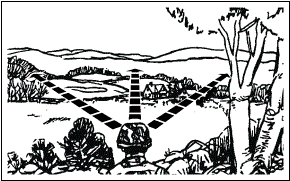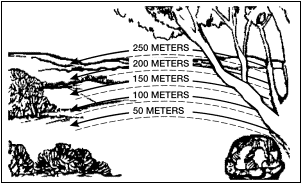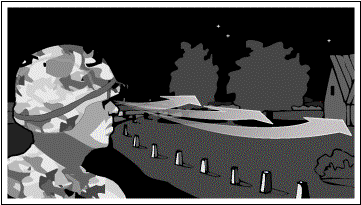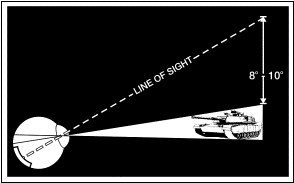|
Conditions:
Given an enemy force equipped with wheel and
track vehicles within range of sight or
hearing during day and night.
Standards:
Identified 50 percent of the enemy soldiers
and vehicles within field of view using
proper surveillance techniques.
|
Performance
Steps
|
|
1. Conduct a visual search in daylight:.
|
a. Make a fast overall search
of the entire area by raising your
eyes quickly from just in front of
your position to the maximum range
you wish to observe (figure 071-331-0804-1).
(For a wide area, subdivide and
repeat the procedure.)
|
|

Figure 071-331-0804-1.
Fast overall search
|
b. Observe by overlapping,
50-meter-deep strips of terrain in
detail, alternately searching left
to right, right to left (figure 071-331-0804-2).
|
|

Figure 071-331-0804-2.
Overlapping search
|
c.
Search suspicious spots
thoroughly.
|
|
2. Identify improperly camouflaged personnel,
equipment, and positions by looking
for-
|
a.
Camouflage or foliage
that does not match.
|
b.
Dead foliage.
|
c.
Outlines that should be
obscured.
|
d.
Bright colors or
reflections that should be subdued.
|
e.
Tracks, footpaths, and
piles of dirt and litter.
|
f.
Over-clearing of fields
of fire and observation.
|
|
3. Conduct surveillance at night:
|
a.
Accustom your eyes to low
light before night operations by
doing one of the following:
|
(1)
Stay in a secure,
darkened area for 30 minutes (for
example, assembly area at night,
initial rally point).
|
(2)
Stay in a red-lighted
area for 20 minutes, followed by
10 minutes in darkness.
|
(3)
Wear red goggles for 20
minutes, followed by 10 minutes in
darkness.
|
b. Scan search areas at night
by moving your eyes in short, quick,
irregular movements (figure 071-331-0804-3).
|
|

Figure 071-331-0804-3.
Night-vision search
|
c. Use off-center vision to
observe specific objects by looking
about 8 to 10 degrees left, right,
above, or below them (figure 071-331-0804-4).
|
|

Figure 071-331-0804-4.
Off-center vision
|
d.
Preserve night vision
by-
|
(1)
Closing both eyes when
exposed to bright light.
|
(2)
Closing one eye only
and observing with other when
surveillance must be maintained.
|
|
Note. Maintaining surveillance is one of the basic, critical
combat skills. Because it is hard to
tell if the above techniques are used,
frequent training is the only way to
ensure mastery of this skill. This
task is easy to integrate with other
tactical training. In addition to the
training given above, frequent
familiarization with the sounds of
vehicles and weapon fire, along with
common smells, such as gasoline,
campfires, and deodorants in the field
environment is recommended.
|
Evaluation Preparation:
Setup:
During a field exercise that involves
camouflaging, have soldiers conduct day and
night surveillance. Simulate situations
described below. Have each soldier conduct
surveillance at night and during the day
before scoring the soldier GO or NO GO.
Situation 1, day surveillance.
a.
Improperly camouflaged enemy soldiers in
fighting positions.
b.
Stationary, properly camouflaged vehicles.
Situation 2, night surveillance. Moving and stationary enemy
soldiers silhouetted on the skyline.
Brief
Soldier: Tell the soldier he must
conduct surveillance during the day and at
night. During surveillance, the soldier must
locate 50 percent of the enemy soldiers
within his field of view, and must
differentiate between a tracked-vehicle and
a wheeled-vehicle.
|
Performance
Measures
|
GO
|
NO
GO
|
|
1. Identified the following situations during
daylight:
|
—
|
—
|
a.
50 percent of improperly
camouflaged enemy soldiers in
fighting positions.
|
|
|
b.
A
camouflaged wheeled vehicle and a
tracked vehicle.
|
|
|
|
2. Identified the following situations during night
surveillance.
|
—
|
—
|
a.
Moving enemy soldiers.
|
|
|
b.
Stationary
enemy soldiers.
|
|
|
Evaluation
Guidance:
Score the soldier GO if all
performance measures are passed. Score the
soldier NO GO if any performance measure is
failed. If the soldier scores NO GO, show
him what was done wrong and how to do it
correctly.
|
References
|
|
|
Required
|
Related
|
|
|
FM
21-75
|
|
|